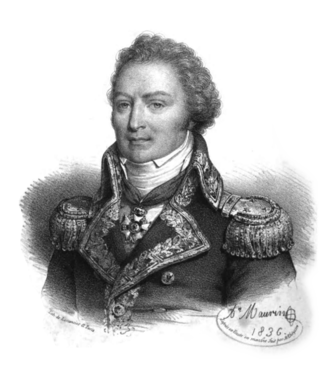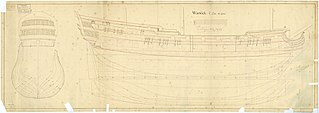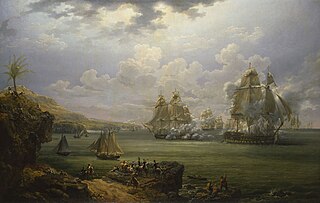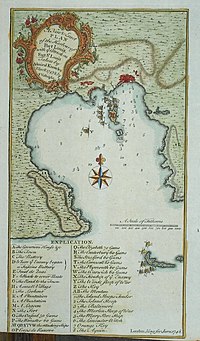
Count Toussaint-Guillaume Picquet de la Motte, also known as La Motte-Picquet was a French Navy officer and admiral. Over a career spanning 50 years, he served under Louis XV and Louis XVI and took part in 34 campaigns. He fought in the Seven Years' War and in the Naval battles of the American Revolutionary War, earning the ranks of Commandeur in the Order of Saint Louis in 1780, and of Grand Cross in 1784. He died during the French Revolution.

Louis-René Madelaine Le Vassor, comte de La Touche-Tréville was a French admiral. He fought in the American War of Independence and became a prominent figure of the French Revolutionary Wars and of the Napoleonic wars.

Charles-Alexandre Léon Durand, Comte de Linois was a French admiral who served in the French Navy during the reign of Napoleon Bonaparte. He commanded the combined Franco-Spanish fleet during the Algeciras Campaign in 1801, winning the First Battle of Algeciras before losing the Second Battle of Algeciras. He then led an unsuccessful campaign against British trade in the Indian Ocean and South China Sea in 1803, being defeated by a harmless fleet of the East India Company during the Battle of Pulo Aura and ending his cruise and sea-going career being bested in battle by John Warren in the action of 13 March 1806. Following the Bourbon restoration, Linois was appointed Governor of Guadeloupe. He supported Napoleon during the Hundred Days and so, on his return to France, he was forced to resign and was court martialled. Although acquitted, he was placed in retirement and never served again.

The Battle of Havana was a naval engagement that took place between the British Caribbean squadron and a Spanish squadron based near Havana during the War of Jenkins' Ear. The battle occurred on the morning of the 12th and ended on 14 October 1748. The belligerents consisted of two squadrons under the command of Admiral Don Andres Reggio of the Spanish Navy and Admiral Sir Charles Knowles of the Royal Navy, respectively. The British succeeded in driving the Spanish back to their harbour after capturing the Conquistador and ran the vice-admiral's ship Africa on shore, where she was blown up by her own crew after being totally dismasted and made helpless. Although the advantage had clearly been with Knowles, he failed to use this to deliver a decisive blow. The battle was the last major action in the War of Jenkins' Ear which had merged with the larger War of the Austrian Succession.

Tyrannicide was a 74-gun ship of the line of the French Navy.

Étienne Eustache Bruix was a French Navy officer and admiral, and Minister of the Navy.

HMS Burford was a 70-gun third rate ship of the line of the Royal Navy, built at Deptford Dockyard to the 1719 Establishment, and launched on 19 July 1722. Burford was notably the early posting of both John Forbes and John Byng, both of whom rose to become Admirals.

HMS Warwick was a 60-gun fourth-rate ship of the line of the Royal Navy, built to the 1719 Establishment at Plymouth by Peirson Lock. The keel was laid down on 1 April 1730, and the ship was launched on 25 October 1733, and completed on 24 August 1734.

The Battle of La Guaira or La Guayra, took place on 2 March 1743 in the Caribbean, off the coast of La Guaira, present day Venezuela. La Guaira was a port of the Royal Gipuzkoan Company of Caracas, whose ships had rendered great assistance to the Spanish navy during War of Jenkins' Ear in carrying troops, arms, stores and ammunition from Spain to her colonies, and its destruction would be a severe blow both to the Company and the Spanish Government. A British expeditionary fleet under Sir Charles Knowles was defeated, and the expedition ended in failure. 600 men were killed, among whom was the captain of HMS Burford, and many of the ships were badly damaged or lost. Knowles was therefore unable to proceed to Puerto Cabello until he had refitted.

The Battle of Cap-Français was a naval engagement during the Seven Years' War fought between French and British forces outside the harbour of Cap-Français, Saint-Domingue on 21 October 1757.

John Perkins, nicknamed Jack Punch, was a British Royal Navy officer. Perkins was perhaps the first mixed race commissioned officer in the Royal Navy. He rose from obscurity to be a successful ship's captain in the Georgian Royal Navy. He captained a 10-gun schooner during the American War of Independence and in a two-year period captured at least 315 enemy ships.

The 2nd battle of Santiago de Cuba, which took place on 9 April 1748, was a failed attempt by elements of the British Royal Navy under Rear-Admiral Charles Knowles to force the entrance of the port of Santiago de Cuba with the aim of striking a blow to the Spanish trade and privateering, since Santiago was a major base of the Spanish privateers in the Caribbean. Two British ships of line were put out of action by the batteries of Morro Castle and had to be towed to open sea. The remaining British warships retreated soon after.

The Battle of Jean-Rabel consisted of two connected minor naval engagements of the French Revolutionary Wars and the Haitian Revolution. The first engagement saw an overwhelming British Royal Navy force consisting of two ships of the line attack and destroy a French Navy frigate in Moustique Inlet near the town of Jean-Rabel on the Northern coast of the French colony of Saint-Domingue. The second engagement took place four days later when a force of boats launched from a British frigate squadron attacked the town of Jean-Rabel itself, capturing a large number of merchant ships in the harbour that had been seized by French privateers.

The action of 14 June 1742 was a minor naval battle of the War of the Austrian Succession in which a small British squadron under Captain Richard Norris burned 5 Spanish royal galleys at the French port of Saint Tropez. Norris had surprised the galleys near Sainte-Marguerite and had chased and driven them into the French port. The British captain, in spite of alleged French neutrality, followed the Spanish vessels into the port and destroyed them at slight cost.

The blockade of Saint-Domingue was a naval campaign fought during the first months of the Napoleonic Wars in which a series of British Royal Navy squadrons blockaded the French-held ports of Cap-Français and Môle-Saint-Nicolas on the northern coast of the French colony of Saint-Domingue, soon to become Haiti, after the conclusion of the Haitian Revolution on 1 January 1804. In the summer of 1803, when war broke out between the United Kingdom and the French Consulate, Saint-Domingue had been almost completely overrun by Haitian Armée Indigène troops led by Jean-Jacques Dessalines. In the north of the country, the French forces were isolated in the two large ports of Cap-Français and Môle-Saint-Nicolas and a few smaller settlements, all supplied by a French naval force based primarily at Cap-Français.
The Capture of Cayenne was a minor military event on the 22 September 1667 during the final stages of the Second Anglo-Dutch War. The French settlement of Cayenne under the French Governor Lefebvre de Lézy was captured in an assault by English sailors and troops of Rear Admiral Sir John Harman's squadron. The English then occupied the settlement stripping it of anything of value before departing two weeks later.
HMS Flying Fish was a 6-gun schooner taken into Royal Navy service in 1793. Flying Fish is notable for being the first ship in which William Beatty served as acting-surgeon from 1793 to 1794. Beatty was the naval surgeon who would go on to famously treat Admiral Nelson at the Battle of Trafalgar in 1805.
Philippe-François Bart Grandson of Admiral Jean Bart, was a French naval officer who was Governor of Saint-Domingue from 1757 to 1761 during the Seven Years' War.
Étienne Cochard de Chastenoye was a French colonial soldier who was interim governor of Saint-Domingue (Haiti) three times in the 18th century.
Rear-Admiral Polycarpus Taylor was a Royal Navy officer of the eighteenth century, most notable for his service commanding ships in the West Indies during the War of the Austrian Succession. Having joined the Royal Navy some time before 1733, Taylor then served at the Battle of Cartagena de Indias and Invasion of Cuba before being promoted to commander in 1742. After commanding several vessels and being promoted to post-captain, in August 1744 Taylor took command of HMS Fowey; serving in the English Channel he ran ashore and destroyed the French privateer Griffon in 1745.
















